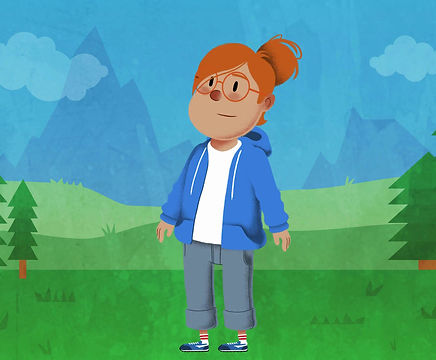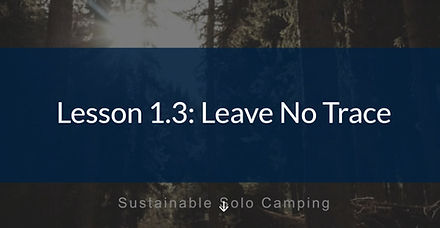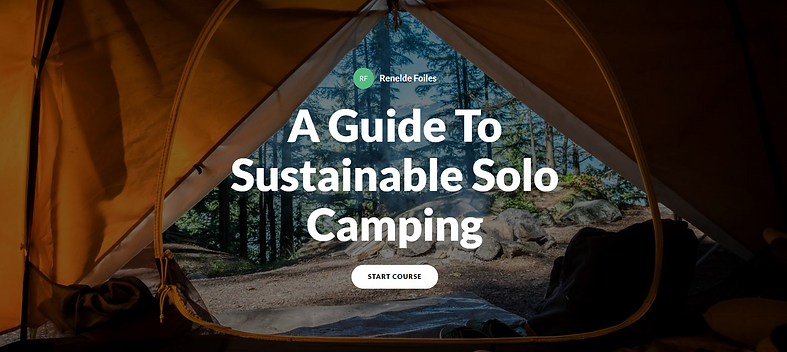
A Guide to Sustainable Solo Camping
In creating A Guide to Sustainable Solo Camping course, I envisioned an online journey where learners could confidently embark on their solo adventures, embracing serene landscapes with both confidence and care. Each lesson is designed as a stepping stone, guiding learners to set up a perfect campsite, minimize their environmental impact, and plan a safe and fulfilling solo expedition. The goal of this course is to empower learners with the critical skills and knowledge required to reduce their environmental footprint while enjoying nature independently.

Audience:
The course was designed for a diverse audience of learners which may include professionals seeking a respite from the urban environment, educators looking to expand their outdoor skills, and nature enthusiasts who wish to deepen their understanding of responsible camping practices.
Authoring Tools:
Articulate Rise 360
Adobe Captivate
Artsteps
ElevanLabs
Canva
Course Objective:
This course is designed to empower beginner solo campers with the skills and confidence required to plan and execute a sustainable camping trip. Throughout this course, learners will achieve proficiency in identifying crucial campsite components such as shelter, cooking facilities, and safety equipment. They will also master the Leave No Trace principles, with a particular emphasis on protecting soil and foliage to minimize their environmental impact. By the end of this course, participants will have developed a comprehensive camping trip plan that integrates essential camping gear selection, effective safety measures, and strategies to reduce environmental impact.
Process:
Identify ID problem, meet with SME to create task analysis, conduct needs and learner analysis, develop learning objectives with bloom's taxonomy table of objectives to align knowledge and cognitive process dimensions, design multimedia plan, storyboard (visual and written), objective-activities-assessment outline, Gagne's Nine events planning grid, action map, style guide, create assets received formal feedback from colleagues.
_edited.png)
Sustainable Practices: Leave No Trace Animated Videos

Tools Used:
ChatGPT: Used for scripting and content development.
ElevenLabs: Employed for generating a lifelike and engaging narration.
Adobe Captivate: Utilized for interactive elements and animations to illustrate the Leave No Trace principles.
Canva: Used for additional graphic design and animation.
Overview:
I created this animated video to provide a comprehensive guide to the Leave No Trace principles, focusing on how to camp sustainably and responsibly in natural environments. This video serves as a visual and educational resource, breaking down essential practices for minimizing environmental impact while solo camping.
Purpose/Intended Audience:
This video is designed to educate beginner to intermediate solo campers about the importance of minimizing their environmental footprint. My aim is to instill sustainable practices among campers, ensuring they understand how to preserve the natural beauty and integrity of outdoor settings. I wanted to reach out to campers who are passionate about nature and eager to learn how to protect it.
Process:
My process started with drafting a script that encapsulates the essence of the Leave No Trace principles. Using insights from ChatGPT, I ensured the content was both informative and engaging. Once the script was finalized, I brought it to life through animations created in Canva and Adobe Captivate, focusing on visual appeal and educational value. To enhance the viewer's learning experience, I used ElevenLabs to generate clear and engaging narration, making the video both informative and easy to follow.
Outcome: The video successfully outlines each of the Leave No Trace principles through engaging animations and clear narration, making complex environmental ethics accessible and understandable. It encourages campers to adopt these practices, potentially leading to a reduced impact on the environments they visit.
Micro-learning Articulate Rise Presentations

Tools Used:
Articulate Rise 360: Used to construct the 3D virtual campsite environment, allowing for interactive learning experiences.
Canva: Employed for designing supplementary visuals and instructional elements within the VR environment.
Overview:
I developed a series of microlearning presentations using Articulate Rise to provide targeted, bite-sized learning experiences focused on sustainable solo camping. These interactive lessons guide learners through essential topics, from campsite safety to Leave No Trace principles, offering an engaging and practical approach to mastering solo camping skills.
Purpose/Intended Audience:
These microlearning presentations are designed for solo campers seeking to enhance their knowledge and confidence in camping safely and sustainably. The content is especially valuable for beginners and intermediate campers who want to deepen their understanding of key camping concepts in a structured yet flexible learning format. My goal was to create accessible, on-demand learning experiences that cater to the needs of campers at various skill levels.
Process:
I began by identifying key topics that are crucial for solo camping, such as campsite setup, emergency response, and bear safety. Using Articulate Rise, I created interactive modules that include scenario-based learning, quizzes, and multimedia elements like videos and infographics. Each presentation was designed with user engagement in mind, incorporating clear navigation, visual aids, and practical examples to reinforce learning. To ensure accessibility and ease of use, I tested the presentations across different devices and made adjustments to optimize the user experience.
Outcome:
The microlearning presentations have proven to be an effective tool for delivering essential camping knowledge in a concise and engaging manner. Learners have reported increased confidence and preparedness for solo camping trips, with a greater understanding of how to camp sustainably and safely. The flexibility of these presentations allows learners to absorb the material at their own pace, making it a valuable resource for ongoing learning and reference.
VR Exhibition
Tools Used:
Articulate Rise: Utilized to develop the interactive microlearning presentations, enabling a seamless and engaging learning experience with built-in multimedia elements, quizzes, and scenario-based interactions.
Canva: Used to create custom graphics and visual aids that enhance the instructional content, making complex concepts more accessible and visually appealing.
Overview:
I created this virtual reality exhibit to offer an immersive experience tailored specifically for solo campers. Users interactively explore various campsite setups and learn how to effectively use camping gear in a simulated environment, making it an engaging and practical learning tool.
Purpose/Intended Audience:
This exhibit is designed to help learners understand the practical aspects of setting up and managing a campsite alone. It's particularly beneficial for those new to camping, providing a safe and controlled space to learn and practice essential skills before hitting the trail. My goal was to create an interactive and engaging way for beginner campers to gain confidence in their abilities.
Process:
I developed this artifact by first creating a detailed 3D model exhibit and with an interactive tour feature using Artsteps. I designed designated sections for each element of a campsite, from tent placement to cooking areas, to offer hands-on learning without the real-world consequences. To enhance visual appeal, I used Canva for additional graphics and design elements. The combination of these tools allowed me to create a realistic and educational experience.
Outcome:
The VR exhibit has been instrumental in providing a realistic yet controlled environment for campers to engage with essential camping skills. It enhances the learner’s ability to apply practical knowledge in real-world camping scenarios, increasing confidence and competence in solo camping adventures.




